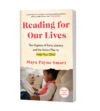The reassuring authors of raise-a-reader books often prescribe a chill pill and a nightly dose of bedtime stories to parents anxious about their kids’ reading. They devote page after page to poignant stories of family reading, complete with shared laughs and smiles, the warmth and comfort of a parent’s lap, and the smell and feel of a book’s spine cracked open for the first time.
I love the joy-of-reading sentiment and the moving accounts of family memory-making around books, but I worry about the comparative silence around other literacy-building activities. The groundswell of storytime support (though well-deserved) leads many parents to wrongly conclude that reading aloud regularly is all it takes to raise thriving readers.
There’s danger in declaring that the achievement of life goals (like college, fulfilling work, economic independence) will “flow naturally” from a love of books and stories—as New York Times Book Review editors Maria Russo and Pamela Paul do in How to Raise a Reader. There’s a risk in urging us to focus on the “pure” pleasure of reading and to leave the nuts and bolts of phonics, assessments, and benchmarks to schools. There’s a cost to minimizing the role of direct skills instruction in the home and framing it as a boring pursuit best left to teachers.
In reality, there’s so much more than reading aloud that we should do to support our children’s literacy, from building oral language skills through intentional conversation to directly teaching letter names and sounds when needed. And, frankly, most of us can’t afford to rely on schools alone to teach reading skills. Schools simply aren’t equipped to get the job done without outside help. Witness the skyrocketing demand for private tutoring in the elementary years and the low reading achievement scores among demographics that can’t access supplemental instruction.
Children whose parents can’t (or won’t) afford expensive remediation are far-too-frequently suffering long-term and even lifetime consequences. And families whose parents can (and do) purchase extra help for their children are losing dollars and hours that might well have been saved through proactive literacy activities in the early years.
Keeping it real, here are four reasons why parents need to learn to teach—not just model—reading:
1. Parents are best positioned to lay a strong foundation for literacy. The groundwork for successful reading is laid in the pivotal first five years of life. As children’s first teachers, parents need to know how reading develops if we are to play our role to full advantage. Parents are fully capable of bolstering pre-reading skills in fun and effective ways from day one.
Limiting our literacy activity to reading bedtime stories essentially means forfeiting considerable power to seed reading success. Instead, we should be laying the reading groundwork by consciously boosting oral literacy skills, directly teaching letter sounds and names, and intentionally directing kids’ attention to print conventions, such as reading from left to right and from top to bottom.
Kindergarten language skills are the single best predictor of school achievement across all subjects in third and fifth grade.
2. Parents who understand typical reading development are more attuned to early risk factors and warning signs of challenges. The first signs of dyslexia can emerge in children as young as one to two years old, long before school starts. Parents are uniquely well-suited to monitor early developmental milestones and to discover any family history of reading trouble—making it more likely children will receive timely intervention if they need it and thus boosting the odds of success.
3. We can’t assume our children will receive quality reading instruction in school. Sadly, teacher inexperience, muddled curriculum, and schools’ weak assessment and remediation capacity combine to hobble most students’ reading progress. The National Council on Teacher Quality evaluated universities a few years ago on how well they were preparinge teachers to teach reading, and dozens of them earned failing marks—including highly regarded schools of education.
Just 37 percent of teacher preparation programs trained prospective teachers in the best evidence-based reading instruction methods at that time. Only 11 states effectively tested special education and elementary teacher candidates on their science-of-reading knowledge and skills. And in some publicly funded universities, teacher candidates received as little as 20 minutes of phonics instruction in their two-year-long teacher prep programs. All that means that many teachers in service now missed out on fundamental preparation to effectively teach reading.
4. Kids need well-informed advocates within schools to ensure that their individual needs are met. When kids enter school, our role as parents expands to include overseeing how well our children’s school, teachers, and curriculum meet their needs. We’re only prepared to do that work well when we’ve already put in the time to understand typical reading development, to recognize when our children are on the path, and to grasp what’s needed to foster future growth.
I understand where cognitive scientist Daniel Willingham is coming from when he warns parents to “resist the urge to engage in reading instruction unless you have reason to believe you know what you’re doing” in his book, Raising Kids Who Read. And I’m calling on all parents to accept the challenge of learning what to do to teach reading. Your child’s education just might depend on it.
To help, I’ve crafted a digital course that’s designed to be a kind of reading boot camp for parents. It’s a small time commitment, all done on your own schedule. In it, parents learn easy, fun, high-impact ways to prepare kids aged 0-5 for reading success in kindergarten and beyond. Check out Reading Made Simple now!
Pin Me for Reference 📌:




